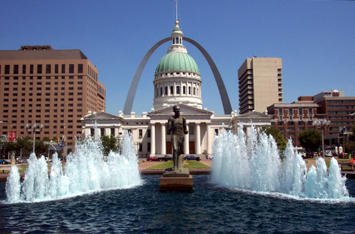
The night of the election, my husband and I greeted with elation the news that the presidency would go to Barack Obama. Then, seconds later, we hunkered down on the sofa with anxious expressions and asked the talking heads: “What about Missouri?”
It’s our state, and we want to know just where we stand as residents and in which direction the region is headed, but we also find it embarrassing to live in a red state. Our friends who live elsewhere pay little, if any, attention to what goes on here in St. Louis. In conversation, it’s hard not come away with the impression that they assume we are bereft of cultural institutions, public transportation, nightlife, public parks, ethnic and racial diversity, creative schools or, even, sometimes, vegetables. All of these assumptions are more about the amorphous realm of culture than they are about the bread-and-butter issues that determined this election. Yet, somehow, it is the amorphous that defines who I am the moment that I hear Missouri labeled “red state.”
So, as it began to look like McCain was going to eke out a victory in Missouri, I did what all upper middle-class people in the United States do when anxious: I went online. My interest was in how the city of St. Louis compared to those cities where many of my friends live and where, frankly, I have often wished to live myself. I looked up the percentage of voters who favored Obama in the counties that included my “destination cities.” And, from greatest to least, here’s what I found:
Washington D.C.: 92.9%
San Francisco: 84.7%
St. Louis: 83.7%
Philadelphia: 83%
Brooklyn: 78.9%
Boston: 77.5%
Portland: 77%
Santa Fe: 76.8%
Chicago: 76.1%
Denver: 75.3%
Queens: 74.4%
Seattle: 71.4%
Los Angeles: 69.3%
New York: 62.1%
That’s right: The city of St. Louis is one of the bluest places in America.
There, are, of course, several caveats. St. Louis City, as opposed to St. Louis County, which includes the city’s suburbs, is incredibly small. I live in St. Louis County, where a far less dramatic proportion of folks, 59.5%, favored Obama. Yet, the inclusion of comparable areas in other cities, say, Riverside County for Los Angeles, where 50.8% of voters went for Obama, would yield a similar result. And for all the claims that Obama’s victory is ushering in a post-racial era, it’s hard not to draw the conclusion that race had some role to play in places with large African American populations like D.C., Philadelphia, and St. Louis. Indeed, Missouri’s own status as red or blue rests on how many provisional ballots state officials will count, and most of those provisional ballots were cast in African American neighborhoods in St. Louis and Kansas City, where voters waited in line long into the night. Nonetheless, even taking into account urban size and white flight, it would appear that people who live in blue cities are often (but, of course, not always) next door to or at least near to, red counties.
In the 1990s, red and blue state labels were shorthand for the policies that shaped funding for the arts and affirmative action and gay and lesbian rights. To a lesser extent, they were also about health care and education and housing and poverty and the perception of the U.S. abroad, but I can’t say that either set of issues jumped to mind when I heard the term: “red state, blue state.” Instead of culture wars, I more often thought of a battle between cultures of consumption – which cars were on the road, which greens were available at the supermarkets, the density of independent bookstores.
These are rarely the images that spring to my mind now, nor are carbon emissions or food policy or literacy. For the first time in my voting life, I am preoccupied more by what I can do and less by what I can buy.
I may have changed my opinions because I’m older, employed, and a parent. Nonetheless, I now think that to be blue on those all-too-simple electoral maps has a new meaning. I think it carries with it a new responsibility to talk to neighbors and to follow those issues that seem to cut through partisan divides, issues like economic security, public transportation, education, health care, and insuring a safe local and global environment.
I thought about this new sense of responsibility this morning. I headed out my front door, turned right, and walked 110 steps. As red leaves fell, I stood in one of the bluest cities in America.
Flannery Burke is an assistant professor in the Department of History at St. Louis University. Originally from Santa Fe, New Mexico, she writes about the American West, the environment, Los Angeles, and St. Louis.












